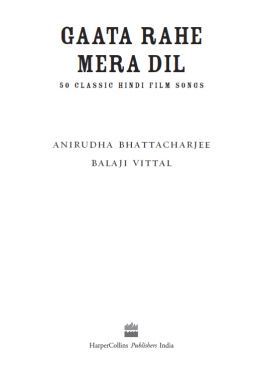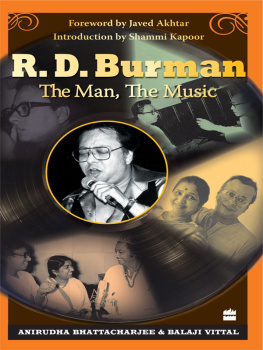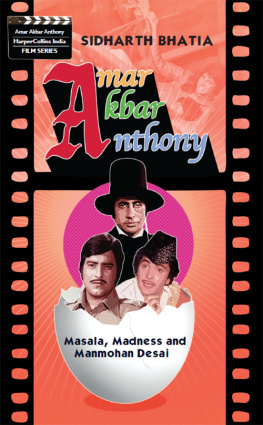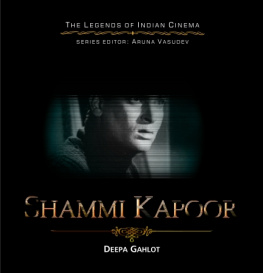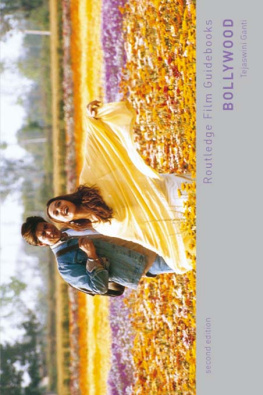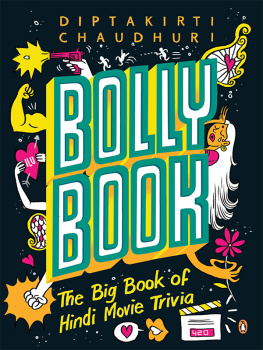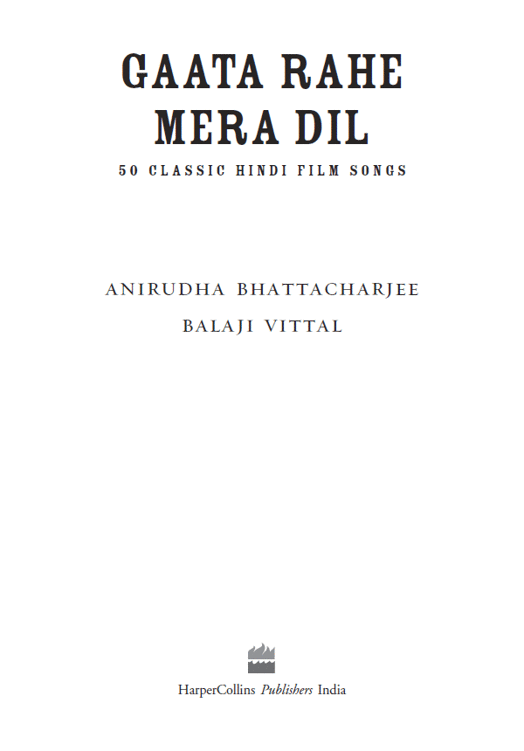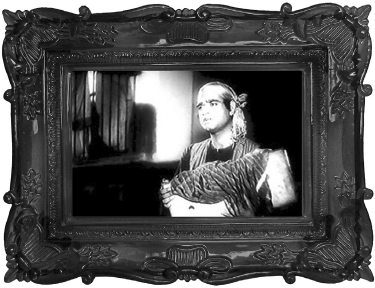PRAISE FOR R.D. BURMAN: THE MAN, THE MUSIC
This is a truly authoritative biography, feast not just for RDs myriad admirers, but also an entire generation of Hindi film music loversthis is a genuine music lovers tribute. Embellished with an amazing array of anecdotes, interviews and incisive observations by his contemporaries and competitors, this book deserves all the praise that it gets Chandan Mitra,
India Today[A story] told well in delectable detail [the authors] have done great service to Hindi cinema by bringing out this book. For fans of R.D. Burman, this should be a Bible
HinduWith interesting anecdotes the book speaks in a lucid style Certainly worth a read
The Indian Expressthe authors excel in their understanding of both folk and Indian classical world The information is first-hand and authentic[this book] is magisterial in its depth and insight Joy Bhattacharjya,
Pioneermeticulously researchedan enjoyable and fruitful read, not only for the RD fanatic but also the general lover of film music this promises to be the definitive book on the maverick musical genius Sidharth Bhatia,
The Asian Agefinely written, clear-eyed and informative
OutlookIts a relief to come across the balanced, no-nonsense
R.D. Burman:The Man, the Music. This is a real book, not an extended monograph . a treasure trove for the intense R.D. acolyte, mother lode for the average enthusiast
Forbes IndiaWHEN Shantanu Ray Chaudhuri came up with the idea of the book, we started wondering. Fifty Hindi film songs? To have to select fifty songs from an estimated repository of around a hundred thousand is like being sent to Ali Babas cave of treasures with no hand baggage.
We knew that there could never be a list of definitive fifty Hindi film songs. Never. Unfortunately, we have been able to include only about 20 per cent of our personal favourite top fifty songs. Every time we got down to discussing it, the list kept changing.
Hence, there is no denying the possibility of heartburn on your favourite number not featuring in this list. Most of ours didnt, either. So dont shoot the authors! Blame it on the publisher! Hindi film music has far more to offer than what we could gather in our arms. There could be at least ten, if not more, books befitting the title Landmark 50 Playback Songs.
This book is not a judgemental statement by us. It is just a representative selection using an algorithm that covers decades, composers, lyricists, genres, singers, actors and film-makers. Various aspects like melody, rhythm, musical arrangement, genre, situational fit, the landmark value, etc., were considered. Which is why the intrinsically classical Poochho na kaise maine rain bitaayi appears on the list as does Aap jaisa koi, which ushered in a new sound in Hindi film music. If the four back-to-back song sequence in Hum Kisise Kum Naheen appears for the sheer innovativeness of the format and its wow! quotient, Dil hai chhota sa finds a place for introducing the biggest music icon of modern times to us.
Lest the term algorithm hints at any scorecard-based selection process, let us clarify that the songs were selected straight from the heart. And the process of scripting each of the stories needed as much passion to write as it took wanderlust. From the leafy hamlets of Kochi to the serenity of a gurukul in the outskirts of Bhubaneshwar to a cheese farm in Coonoor, not to speak of the metro cities, for us this book is as much a travelogue.
The songs featured in this book span the era 1935 to 1993. Why 1993? Because we thought that for a song to be regarded as a classic, it needs to resonate with listeners at least twenty years after they were first enraptured by it. This takes care of the danger of falling into the trap of the instant classic.
Theres much more to film music than the singer, composer, lyricist and the assistants. Innumerable musicians, sound recordists, studio staff, all gifted beyond imagination, have dwelt in relative obscurity to contribute in their own way. They too deserve a standing salute.
We regret the absence of many greats in the book. To name a few: Kanan Devi, HusnlalBhagatram, Sajjad Hussain, Timir Baran, G.M. Durrani, Noorjehan, Shamshad Begum, Rajinder Krishan, Ravi, Hansraj Behl, Mahendra Kapoor, N. Dutta, SonikOmi, SapanJagmohan, Usha Khanna, G.S. Kohli, Kanu Roy, S.P. Balasubramanyam, Suresh Wadkar, Hariharan, etc.
We can have them in another book. Meanwhile, we would like your take on this list and would also love to have your own list of Top 50 Hindi film songs and in the process make this book an interactive, ongoing venture.
: A song before playback became the order of the day
THE LAST NAWAB AND THE FIRST
Babul moraa, naihar chhooto hi jaye
FILM: STREET SINGER (1938)
MUSIC: RAI CHAND BORAL
LYRICS: TRADITIONAL (SOURCES SAY WAJID ALI SHAH)
SINGER: KUNDAN LAL SAIGAL
THE singer walked the street as his people wept. The pareekhana would no longer hear the patter of dancing feet. Never again would the city witness the generous Jogia Jashn on the nawabs birthday. The corridors of the magnificent Qaisarbagh Baradari would no longer reverberate with the sound of music. No longer would men and women take to the streets, bedecked and joyous, on the occasion of Raas Leela. The balconies, once chock-a-block with people jostling for space, trying to hear the soulful dirges, would now hang neglected. The colourful bazaars would wear a pall of gloom.
In February 1856, on the basis of Captain Westons exhaustive account, General Outram decreed that the province of Oudh (Awadh) was to be annexed. Nawab Wajid Ali Shah was ordered to vacate his capital, Lucknow.
Thus, the poet-ruler had to leave his throne, his people and city. The poets wrote:

